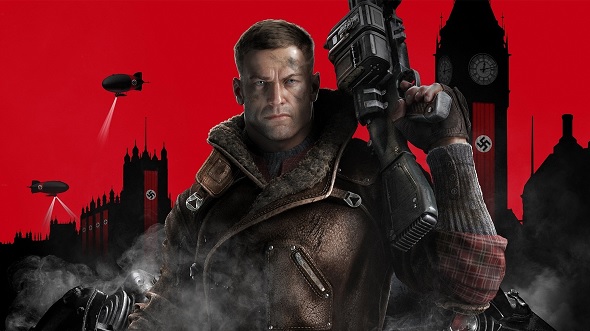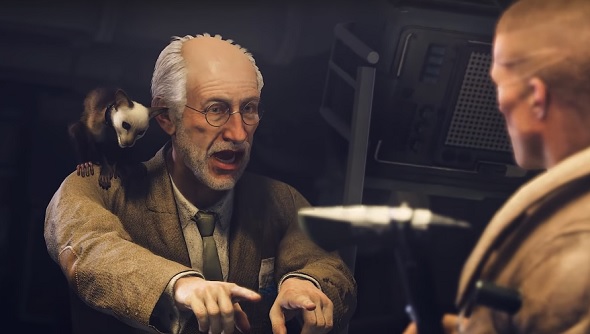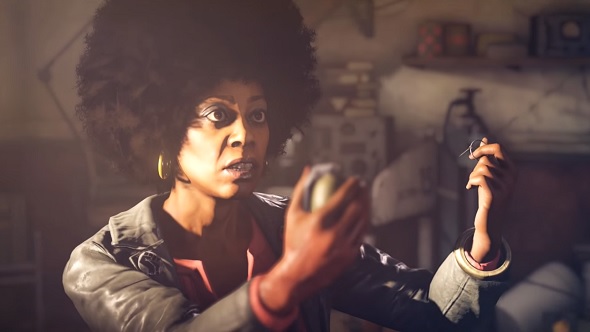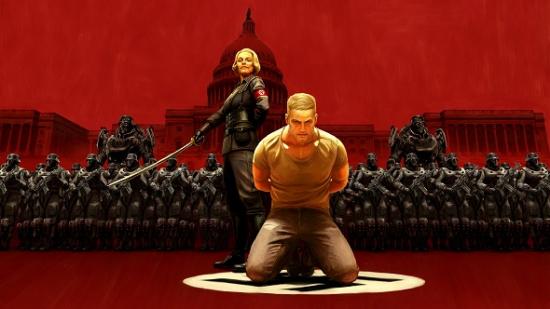This article contains spoilers for Wolfenstein II: The New Colossus.
B.J. Blazkowicz is one of gaming’s longstanding heroes, but until 2014 he had about as much characterisation as Doomguy – nothing more than an unseen body behind the camera created for the sole purpose of extinguishing the lives of two-dimensional Nazis.
Find out how MachineGames made the shooting in Wolfenstein II feel so good in our interview article.
Wolfenstein’s soft reboot in 2014, along with its recent sequel, has taken the series into the modern day by weaving a character-driven story in and around the gunshots. A story that interposes a serious heart-to-heart between expecting parents over the father’s impending demise with literal toilet humour. The new Wolfenstein games are not afraid to cut through a sentimental scene, or even a horrific one laced with Nazi ideology and torture, with a stab at comedy.
However, one subject that developers MachineGames do not laugh off is the inherent racism of 20th-century America. The unbroken message throughout both games is that the wonderful country Blazkowicz claims to fight for is wholly different to the America that people of colour know. When confronted by J – who is clearly made to resemble Jimi Hendrix – on the similarities pre-war America shared with Nazism, Blazkowicz responds violently.
This subject is brought further into the foreground in The New Colossus, not only through flashback segments featuring B.J.’s racist father, but by introducing the Black Revolutionary Front and their leader Grace Walker.

Aside from being a certifiable badass able to make even Terror Billy jump, Grace is a more consistent character who is perfectly placed to take the lead role after the series protagonist literally loses his head. Grace is the last major crew member to accept the turncoat Nazi, and for good reason: she sees little difference between them and her previous neighbours. This is explored further as Grace recounts her experience of the nuclear attack on New York. Her words will be hauntingly familiar to anyone who has listened to the accounts of Hiroshima and Nagasaki survivors.
Grace is entirely disillusioned with American exceptionalism and is Wolfenstein II’s most intriguing character. The passing of the baton never occurs, however, as B.J. lives on after his death due to returning scientist Set Roth single-handedly figuring out how to perform interspecies head transplants.

The blatant foreshadowing of this deus ex machina, while necessary, removes all the tension from B.J.’s “execution.” Even as Engel pulls back for the second guillotine swing, you aren’t truly concerned. You know Blazkowicz will be fine.
Immediately after the prologue, while you are running around a submarine avoiding your wife, Blazkowicz monologues incessantly about his dying body. While the words are solemn, they lose all gravity as the situation is treated as nothing more than a simple problem with a convenient, if cartoonish, solution. It is quite literally in the room next door.
“My body can’t take much more, lend me your wings Caroline,” Blazkowicz says as he walks away from the doctor who just expounded how he put his dying cat’s head onto a monkey.

This takes all the wind out of The New Colossus’s biggest set-piece, with the only way B.J. can survive requiring plot armour thicker than the power suit he puts on. It is, for my money, a major misstep. Especially when Blazkowicz’s exit could not have been better timed.
Since the beginning of the game it is made clear that Blazkowicz is on his way out, that he is finished. In the events leading up to his execution he condemns his father, punishes him for his betrayal, and accepts his mother’s passing in a rather touching scene. Blazkowicz’s story effectively ends there and goes no further. Sure, he continues to kill Nazis, but for a character-driven game it is jarring that nothing of substance actually happens to the lead after the halfway point. There are no more emotional lines to follow, it’s just a murder party.

On top of this, Blazkowicz’s death would have paralleled Grace’s story with his now widow, Anya. Grace, too, lost her lover to Engel, and is now a mother to a fatherless child, just like Anya. Exploring this further would have allowed us to experience how a partner deals with loss twofold. Played from Grace’s perspective, it could involve lashing out at Super Spesh’s death and perhaps even undergoing an already foreshadowed head transplant to gain the strength of Terror Billy, a nice bit of subversion.
On the other side, we would see how Anya mourns for both B.J. and you – after all, until now, you essentially were Blazkowicz. After being bested by the Nazis, you would still have to walk among the ones you left behind and watch as they dealt with your demise. Telling a story from behind the eyes of others is something that videogames excel at, and it is a shame that it wasn’t explored here to its fullest.
